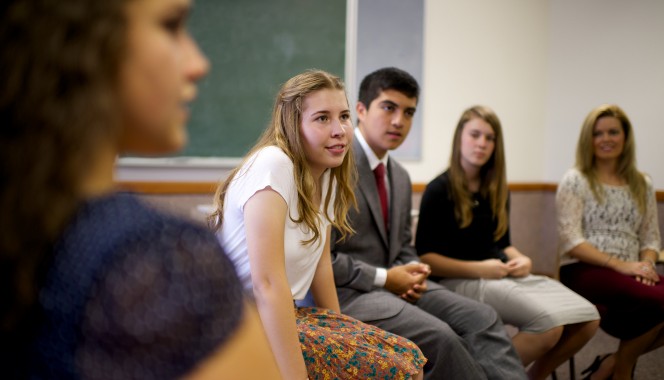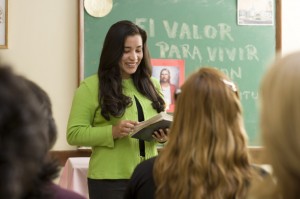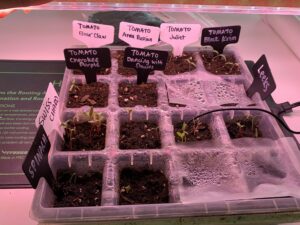Most gospel teachers struggle with classroom participation. Sometimes you’ll get a classroom of students who are very active and loud, and other times you may have a classroom of very quiet students. We want students to enjoy each other, but “between the prayers” we want them to talk about the gospel — not Friday night’s game. Following are some ideas to help you increase appropriate discussion in your classroom:
- Talk Less
- Ask and Pause
- Make your Classroom a Safe Place to Ask Questions and Share Ideas
- Encourage Sincere Participation Attempts
Talk Less
When a teacher takes the spotlight, becomes the star of the show, does all the talking, and otherwise takes over all of the activity, it is almost certain that he is interfering with the learning of the class members. (Teaching the Gospel: A Handbook for CES Teachers and Leaders(1994), 14.)
If you find yourself speaking the majority of class time, you are probably talking too much. You need to give explanations, instructions, examples, stories, testimonies, and so forth, but your speaking should be a pathway to promoting student participation. You might choose to set a goal to have your students speak 40 to 60 percent of the time, or set a goal to have each student participate during each lesson. When teachers talk less, they become facilitators who help students learn from the scriptures, from other students, and from the Spirit. (adapted from Leading Class Discussions, Ensign, June 2009 )
For teaching techniques that help students participate, visit our encouraging student sharing page.
Ask and Pause
“
[N]ever answer your own question!” – Mark E. Beecher, BYU Education Week
Most gospel teachers wait a mere two or three seconds after they ask a question for students to respond and then provide the answer themselves. If you do this, you may inadvertently train students not to participate. Students who are not given enough time to think or for whom an expectation of participation is not set, may stop participating all together.
Robb Jones, head of curriculum development for the church, asked teachers to count silently to 20 after asking a question, giving the class time to ponder. He trained gospel teachers to say things like “I’ll give you time to think” or “Would you please ponder this question, and then I’ll ask for responses.” As teachers began to do this, class participation increased and class members felt the Spirit as they began to “teach one another” (D&C 88:77). (see Leading Class Discussions, Ensign, June 2009 )
I’ve found counting to be an effective way for me to get better responses to questions, too. During the pause, I will think about my question. Was it stated clearly? Should I rephrase? Did I ask students to give information or share experiences they have not had yet? Was the question too personal? Did I set the stage for sharing by giving a personal example myself? Sometimes students who were not focusing on the lesson will ask me to repeat the question, which gets them back on track. Sometimes I ask a poor question. That’s okay — I can rephrase, or I may even say, “That was a bad question. Let me try again.”
Practice asking and pausing to set an expectation of participation in your classroom.
Make your Classroom a Safe Place to Ask Questions and Share Ideas
In order to make your classroom a safe place for sharing ideas, you must never allow students to be rude to each other or to make unkind remarks. I have rarely seen unkind remarks made during adult lessons, but cruel comments are frequently made in classrooms of youth. You might respond by saying in a sharp or stern voice, “That comment was inappropriate/cruel, James. Do not make that type of remark again.” Pause for a brief second after the rebuke, and then move on. Following the advice in D&C 121:43–44:
“Reproving betimes with sharpness, when moved upon by the Holy Ghost; and then showing forth afterwards an increase of love toward him whom thou hast reproved, lest he esteem thee to be his enemy; That he may know that thy faithfulness is stronger than the cords of death.”
Be sure to pull the offender aside after class and reaffirm your love for them, but make it clear that you want participation and appreciate his sense of humor, but cruelty can not be tolerated.
Ensure students recognize that in your classroom all comments and questions are welcome, and that their contributions will not be ridiculed.
Encourage Sincere Participation Attempts
Teachers “can help those [they] teach feel more confident about their ability to participate in a discussion if [the teacher] responds positively to each sincere comment” (Teaching, No Greater Call, 64). Teachers should not ridicule or criticize any questions, comments, expression of feelings, experiences, or testimonies. Teachers should show courtesy and love and do their best to encourage helpful participation… even if sometimes they must kindly clarify doctrinal misunderstandings. Teachers should keep in mind that students are taking emotional and spiritual risks when sharing personal insights. They will hesitate to share again if they do not receive positive feedback. (Increasing Participation in Lessons, Claybaugh and Dahl, Ensign, March 2001)
Some examples of ways to respond to class members’ comments are:
- Thank you for that comment.
- I like the way you put that!
- I think you said it well.
- Let’s write that on the board; it is so insightful.
- Did the rest of you hear that? Please say it again.
- Thank you for sharing your feelings.
- What a wonderful testimony you have shared!
Teachers may also want to respond to comments in ways that encourage more participation by saying:
- That is a good question. Who would like to respond to it?
- That’s interesting. Please explain more of what you mean.
- How did you come to feel that way?
Conclusion
It takes planning and practice, but even the most inexperienced teachers can encourage participation in students by planning lessons in a way that has teachers talking less, asking and pausing, creating a safe place, and encouraging all sincere participation attempts.
Find more ideas on how to plan a great gospel lesson, or check out our increasing participation teaching techniques.



